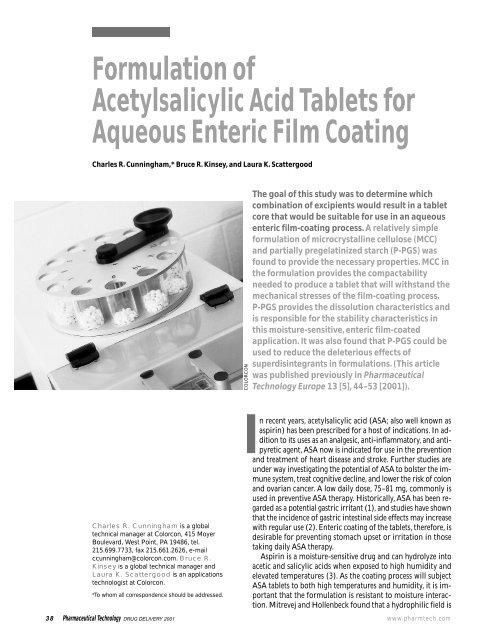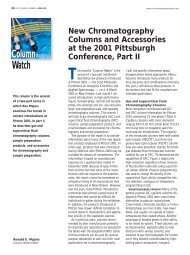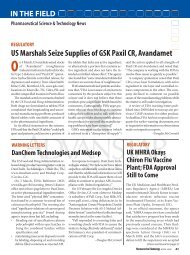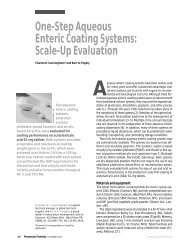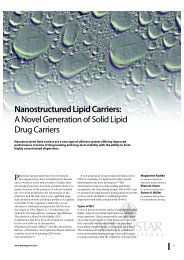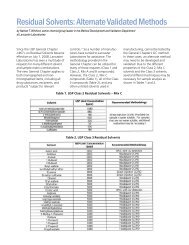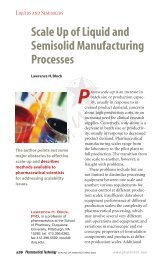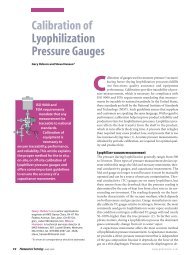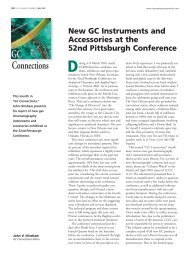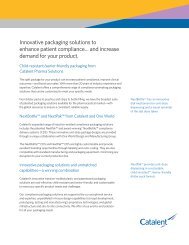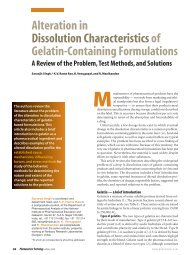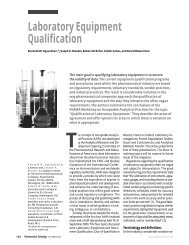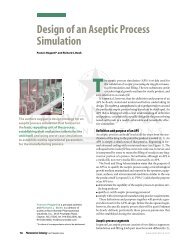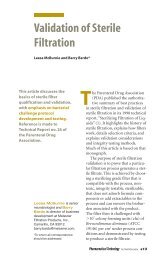Formulation of Acetylsalicylic Acid Tablets for Aqueous Enteric Film ...
Formulation of Acetylsalicylic Acid Tablets for Aqueous Enteric Film ...
Formulation of Acetylsalicylic Acid Tablets for Aqueous Enteric Film ...
Create successful ePaper yourself
Turn your PDF publications into a flip-book with our unique Google optimized e-Paper software.
<strong>Formulation</strong> <strong>of</strong><br />
<strong>Acetylsalicylic</strong> <strong>Acid</strong> <strong>Tablets</strong> <strong>for</strong><br />
<strong>Aqueous</strong> <strong>Enteric</strong> <strong>Film</strong> Coating<br />
Charles R. Cunningham,* Bruce R. Kinsey, and Laura K. Scattergood<br />
COLORCON<br />
The goal <strong>of</strong> this study was to determine which<br />
combination <strong>of</strong> excipients would result in a tablet<br />
core that would be suitable <strong>for</strong> use in an aqueous<br />
enteric film-coating process. A relatively simple<br />
<strong>for</strong>mulation <strong>of</strong> microcrystalline cellulose (MCC)<br />
and partially pregelatinized starch (P-PGS) was<br />
found to provide the necessary properties. MCC in<br />
the <strong>for</strong>mulation provides the compactability<br />
needed to produce a tablet that will withstand the<br />
mechanical stresses <strong>of</strong> the film-coating process.<br />
P-PGS provides the dissolution characteristics and<br />
is responsible <strong>for</strong> the stability characteristics in<br />
this moisture-sensitive, enteric film-coated<br />
application. It was also found that P-PGS could be<br />
used to reduce the deleterious effects <strong>of</strong><br />
superdisintegrants in <strong>for</strong>mulations. (This article<br />
was published previously in Pharmaceutical<br />
Technology Europe 13 [5], 44–53 [2001]).<br />
Charles R. Cunningham is a global<br />
technical manager at Colorcon, 415 Moyer<br />
Boulevard, West Point, PA 19486, tel.<br />
215.699.7733, fax 215.661.2626, e-mail<br />
ccunningham@colorcon.com. Bruce R.<br />
Kinsey is a global technical manager and<br />
Laura K. Scattergood is an applications<br />
technologist at Colorcon.<br />
*To whom all correspondence should be addressed.<br />
In recent years, acetylsalicylic acid (ASA; also well known as<br />
aspirin) has been prescribed <strong>for</strong> a host <strong>of</strong> indications. In addition<br />
to its uses as an analgesic, anti-inflammatory, and antipyretic<br />
agent, ASA now is indicated <strong>for</strong> use in the prevention<br />
and treatment <strong>of</strong> heart disease and stroke. Further studies are<br />
under way investigating the potential <strong>of</strong> ASA to bolster the immune<br />
system, treat cognitive decline, and lower the risk <strong>of</strong> colon<br />
and ovarian cancer. A low daily dose, 75–81 mg, commonly is<br />
used in preventive ASA therapy. Historically, ASA has been regarded<br />
as a potential gastric irritant (1), and studies have shown<br />
that the incidence <strong>of</strong> gastric intestinal side effects may increase<br />
with regular use (2). <strong>Enteric</strong> coating <strong>of</strong> the tablets, there<strong>for</strong>e, is<br />
desirable <strong>for</strong> preventing stomach upset or irritation in those<br />
taking daily ASA therapy.<br />
Aspirin is a moisture-sensitive drug and can hydrolyze into<br />
acetic and salicylic acids when exposed to high humidity and<br />
elevated temperatures (3). As the coating process will subject<br />
ASA tablets to both high temperatures and humidity, it is important<br />
that the <strong>for</strong>mulation is resistant to moisture interaction.<br />
Mitrevej and Hollenbeck found that a hydrophilic field is<br />
38 Pharmaceutical Technology DRUG DELIVERY 2001 www.pharmtech.com
generated around ASA crystals under high-humidity conditions<br />
and that upon combining the ASA with certain hydrophilic disintegrants,<br />
condensation in the vicinity <strong>of</strong> the ASA crystal can<br />
occur (4). The disintegrants studied were sodium starch glycolate<br />
(SSG), croscarmellose sodium (CCS), crospovidone, and<br />
colloidal silica. During the aqueous film-coating process, Faroongsarng<br />
and Peck determined that depth <strong>of</strong> water penetration<br />
into the tablet core could be directly linked to the concentration<br />
and type <strong>of</strong> disintegrant used in the <strong>for</strong>mulation (5).<br />
Further work by Bashar Al-Taani studying aqueous-coating solutions<br />
<strong>for</strong> ASA tablets confirmed that moisture penetration<br />
during the coating process was not only <strong>for</strong>mulation dependent<br />
but could be directly linked to the stability <strong>of</strong> the final<br />
coated ASA tablet (6).<br />
A review <strong>of</strong> ingredients contained in five commercially<br />
purchased ASA products found that, in most cases, the primary<br />
listed excipients were microcrystalline cellulose (MCC) and<br />
some <strong>for</strong>m <strong>of</strong> starch. The use <strong>of</strong> additional excipients including<br />
disintegrants (such as CCS and SSG), lubricants, and<br />
glidants varied. All five products were packaged in foil-sealed<br />
high-density polyethylene (HDPE) bottles, three <strong>of</strong> which contained<br />
carbon–silica desiccant packs.<br />
The goal <strong>of</strong> this study was to determine which combination<br />
<strong>of</strong> excipients found in commercial ASA products would result<br />
in a tablet core that would be suitable <strong>for</strong> use in an aqueous enteric<br />
film-coating process. The ideal enteric-coated tablets would<br />
need to exhibit excellent stability under accelerated storage conditions<br />
without the use <strong>of</strong> extra (and more costly) packaging<br />
precautions such as desiccant packages or other specialized<br />
packaging materials.<br />
Materials and equipment<br />
Aspirin 1040 (Aspirin USP 40-mesh crystals, Rhodia, Cranbury,<br />
NJ) was used as the active material. The excipients used in the<br />
study were partially pregelatinized starch (P-PGS) (Starch 1500,<br />
Colorcon, West Point, PA); MCC (Emcocel 50M, Penwest, Patterson,<br />
NY); SSG (Explotab, Penwest); CCS (Ac-Di-Sol, FMC,<br />
Princeton, NJ); and stearic acid NF (purified vegetable-grade<br />
powder, Oleotec Ltd., London, UK).<br />
The packaging materials used were 85 mL foil-sealable HDPE<br />
bottles (Drug Plastics and Glass Co., Boyertown, PA) and desiccant<br />
packs (3964, Süd-Chemie Per<strong>for</strong>mance Packaging, Belen,<br />
NM). The coating materials used were an aqueous enteric-coating<br />
system (Sureteric) and an aqueous film-coating system<br />
(Opadry II), both manufactured by Colorcon.<br />
Ingredients were dry blended in a 16-quart twin-shell blender<br />
(Patterson-Kelley Co., East Stroudsburg, PA). <strong>Tablets</strong> were compressed<br />
on an instrumented 10-station Piccola rotary press<br />
(Riva, Buenos Aires, Argentina). Tablet hardness was measured<br />
using a Multichek tester (Erweka, Mil<strong>for</strong>d, CT). A side-vented<br />
15-in. coating pan (Labcoat II, O’Hara Technologies, Toronto,<br />
Canada) was used to apply the coatings. A dissolution-test<br />
station (VK 7010, apparatus I, VanKel, Cary, NC) with a UV<br />
spectrophotometer (Varian, Palo Alto, CA) was used <strong>for</strong> drugrelease<br />
testing. An HPLC (high-per<strong>for</strong>mance liquid chromatography)<br />
system (Alliance 2690, Waters Corp., Mil<strong>for</strong>d, MA)<br />
was used to determine free salicylic acid concentration.<br />
Methods<br />
Blending and tablet preparation. Six <strong>for</strong>mulations (see Table I),<br />
composed <strong>of</strong> constant levels <strong>of</strong> ASA and lubricant and varying<br />
levels <strong>of</strong> MCC, P-PGS, CCS, and SSG were each dry blended <strong>for</strong><br />
15 min in the twin-shell blender. The batch size <strong>of</strong> each blend<br />
was 5 kg.<br />
Each <strong>of</strong> the six blends was then compressed on the 10-<br />
station rotary tablet press with 7.0-mm standard concave tooling.<br />
The target tablet weight was 162.0 mg, and the compaction<br />
<strong>for</strong>ce was adjusted to produce tablets with a breaking <strong>for</strong>ce <strong>of</strong><br />
6.0–7.0 kp. The tablet coating was per<strong>for</strong>med in a 15-in. sidevented<br />
pan equipped with one spray gun. The pan load was<br />
3 kg. A subcoat <strong>of</strong> Opadry II dispersed in water (15% w/w) was<br />
applied to obtain a theoretical 2% tablet weight gain to tablets<br />
from all <strong>of</strong> the six batches. The subcoat application was immediately<br />
followed by an enteric coat consisting <strong>of</strong> Sureteric<br />
dispersed in water (15% w/w) and applied to obtain a theoretical<br />
10% weight gain. A topcoat <strong>of</strong> Opadry II dispersed in<br />
water (15% w/w) was then applied to the tablets to obtain a<br />
2% theoretical weight gain. All six coating trials were conducted<br />
using the same recommended process temperatures, spray rates,<br />
and operating conditions. In general, the use <strong>of</strong> a subcoat beneath<br />
the enteric coating is optional and largely depends on<br />
the quality <strong>of</strong> the tablet core. As the six batches contained varying<br />
ingredients, a subcoat was applied to all six batches so that<br />
the enteric layer would be unaffected by minor changes in the<br />
tablet surface. The use <strong>of</strong> a topcoat is optional as well, but<br />
many commercial products have a topcoat applied to color<br />
the core.<br />
Dissolution and free salicylic acid testing. The dissolution and<br />
free salicylic acid tests <strong>for</strong> the uncoated tablets were per<strong>for</strong>med<br />
according to the USP 23 monograph <strong>for</strong> ASA tablets. The coated<br />
Table I: Study <strong>for</strong>mulations.<br />
Concentration (% w/w)<br />
Ingredients A B C D E F<br />
Constant Aspirin 50.0 50.0 50.0 50.0 50.0 50.0<br />
Stearic acid 0.5 0.5 0.5 0.5 0.5 0.5<br />
Study Microcrystalline cellulose (MCC) 49.5 29.5 46.5 46.5 26.5 26.5<br />
variables Starch 1500 (P-PGS) 0.0 20.0 0.0 0.0 20.0 20.0<br />
Croscarmellose sodium (CCS) 0.0 0.0 3.0 0.0 3.0 0.0<br />
Sodium starch glycolate (SSG) 0.0 0.0 0.0 3.0 0.0 3.0<br />
Pharmaceutical Technology DRUG DELIVERY 2001 39
Aspirin released (%)<br />
120<br />
100<br />
80<br />
60<br />
40<br />
20<br />
Breaking <strong>for</strong>ce (kp)<br />
8.0<br />
7.0<br />
6.0<br />
5.0<br />
4.0<br />
Initial<br />
3 months' storage<br />
0<br />
0<br />
5 10 15 20 25 30 35<br />
Time (min)<br />
A (initial)<br />
B (initial)<br />
C (initial)<br />
D (initial)<br />
E (initial)<br />
F (initial)<br />
A (3 months)<br />
B (3 months)<br />
C (3 months)<br />
D (3 months)<br />
E (3 months)<br />
F (3 months)<br />
Figure 1: Comparison <strong>of</strong> uncoated tablet dissolution pr<strong>of</strong>iles be<strong>for</strong>e<br />
and after three months <strong>of</strong> storage at 40 °C and 75% RH.<br />
tablets were tested according to the USP 23 monograph <strong>for</strong><br />
delayed-release ASA tablets.<br />
Tablet-hardness testing. The uncoated tablets were tested <strong>for</strong><br />
diametrical breaking <strong>for</strong>ce be<strong>for</strong>e and after storage at accelerated<br />
conditions. The average result was reported from 20 tablets<br />
tested.<br />
Packaging and stability. Samples <strong>of</strong> the uncoated tablets from<br />
each <strong>for</strong>mulation were packaged in HDPE bottles (120 tablets<br />
per bottle). The coated tablets from each <strong>for</strong>mulation were packaged<br />
in the same manner; however, one set <strong>of</strong> samples was packaged<br />
without desiccant, and a second set <strong>of</strong> samples<br />
was packaged with a desiccant pack in each bottle. All<br />
bottles were induction (foil) sealed and stored under<br />
accelerated conditions (40 C and 75% RH) <strong>for</strong><br />
three months.<br />
Results and discussion<br />
Uncoated ASA tablets. The dissolution testing conducted<br />
in acetate buffer (pH = 4.5) revealed that only batch<br />
A containing MCC alone as the excipient failed to<br />
achieve 80% drug release in less than 20 min. The dissolution<br />
results after storage under accelerated conditions<br />
showed little change from the initial tests (see<br />
Figure 1).<br />
More significant were the results <strong>of</strong> the tablet mechanical<br />
strength after exposure to accelerated temperature<br />
and humidity conditions (see Figure 2). The<br />
tablets containing just ASA and MCC lost 8.57% in<br />
tablet hardness, whereas the tablets containing the<br />
MCC–P-PGS combination showed the least decrease<br />
in tablet hardness with a 3.0% loss. The use <strong>of</strong> either CCS or<br />
SSG in combination with MCC resulted in a loss <strong>of</strong> more than<br />
36.3% in tablet mechanical strength. Interestingly, when the<br />
same levels <strong>of</strong> CCS or SSG were used in the tablets that combined<br />
P-PGS and MCC, the loss in tablet hardness was less pr<strong>of</strong>ound.<br />
When comparing the levels <strong>of</strong> free salicylic acid in uncoated<br />
tablets, at the initial time point and after three months<br />
at 40 C and 75% RH, the results showed a similar trend to the<br />
tablet hardness results (see Figure 3).<br />
The USP limit <strong>for</strong> free salicylic acid in uncoated ASA tablets<br />
is not more than 0.3%. After three months in accelerated conditions,<br />
the tablets containing just MCC as the excipient or MCC<br />
with either CCS or SSG exhibited significantly increased levels<br />
<strong>of</strong> free salicylic acid and failed to meet the USP requirements.<br />
The MCC–P-PGS combination showed virtually no degradation<br />
<strong>of</strong> the ASA with time in adverse storage conditions, and<br />
the increase in free salicylic acid was negligible.<br />
It has been shown that the P-PGS used in this study has a<br />
40 Pharmaceutical Technology DRUG DELIVERY 2001 www.pharmtech.com<br />
3.0<br />
A<br />
B C D E F<br />
Figure 2: Comparison <strong>of</strong> breaking <strong>for</strong>ce <strong>of</strong> uncoated tablets be<strong>for</strong>e and<br />
after three months <strong>of</strong> storage at 40 °C and 75% RH.<br />
Free salicylic acid (%)<br />
6.0<br />
5.0<br />
4.0<br />
3.0<br />
2.0<br />
1.0<br />
0.0<br />
Initial<br />
3 months' storage<br />
A B C D E F<br />
0.130 0.095 0.145 0.153 0.091 0.121<br />
1.117 0.111 5.403 2.329 0.158 0.166<br />
Figure 3: Comparison <strong>of</strong> free salicylic acid <strong>of</strong> uncoated tablets be<strong>for</strong>e and after<br />
three months <strong>of</strong> storage at 40 °C and 75% RH (USP limit NMT 0.3%).
Aspirin released (%)<br />
100<br />
80<br />
60<br />
40<br />
20<br />
0<br />
0<br />
<strong>Acid</strong> phase<br />
(0.1 N HCI)<br />
20 40 60<br />
80 100 120 5 25 45 65 85<br />
Time (min)<br />
lower propensity <strong>for</strong> moisture uptake than either CCS or SSG<br />
and will draw less moisture into a tablet under elevated humidity<br />
conditions (7). This may account <strong>for</strong> some <strong>of</strong> the positive<br />
effects seen with its use in this <strong>for</strong>mulation. The data also<br />
suggest that P-PGS may be able to trap or retain moisture within<br />
the <strong>for</strong>mulation, thus retarding moisture interaction with the<br />
ASA.<br />
Initial results <strong>for</strong> the coated ASA tablets. After coating, the tablets<br />
from all <strong>of</strong> the <strong>for</strong>mulations had a good appearance. None <strong>of</strong><br />
A<br />
B<br />
C<br />
D<br />
E<br />
F<br />
the tablets exhibited any signs <strong>of</strong> defects<br />
either during or after the coating<br />
trials. <strong>Tablets</strong> from all the batches<br />
passed the acid phase <strong>of</strong> dissolution<br />
testing with no release <strong>of</strong> ASA after<br />
2 h in 0.1 N HCl. During the buffer<br />
phase <strong>of</strong> testing (pH = 6.8), as with<br />
the uncoated tablet dissolution results,<br />
only the tablets containing just<br />
MCC and ASA failed to meet the USP<br />
specification <strong>of</strong> not less than 80%<br />
ASA released in 90 min (see Figure 4).<br />
In fact, the other five <strong>for</strong>mulations attained<br />
80% ASA release in less than<br />
20 min.<br />
Coated tablet stability results. After<br />
three months <strong>of</strong> storage at 40 C and<br />
75% RH, some <strong>of</strong> the tablets containing<br />
CCS or SSG exhibited s<strong>of</strong>tening<br />
<strong>of</strong> the film coating and sticking<br />
<strong>of</strong> the tablets to one another<br />
within the HDPE bottles (see Figure<br />
5). This occurred in the samples that were packaged both<br />
with and without desiccant packs. Any tablets exhibiting signs<br />
<strong>of</strong> defects at this point were considered stability failures.<br />
The free salicylic acid results <strong>for</strong> the coated tablets were very<br />
similar to those results obtained <strong>for</strong> the uncoated tablets. The<br />
USP limit <strong>for</strong> free salicylic acid in coated ASA tablets, 3.0%, is<br />
higher than the uncoated tablet specification. After three months<br />
in accelerated conditions, the tablets containing just MCC as<br />
the excipient exhibited higher, but acceptable, free salicylic acid<br />
Buffer phase<br />
(pH 6.8 phosphate buffer)<br />
Figure 4: Initial delayed-release dissolution pr<strong>of</strong>iles <strong>of</strong> enteric-coated ASA tablets.<br />
MCC MCC–P-PGS MCC–CCS<br />
FAIL<br />
FAIL<br />
FAIL<br />
MCC–SSG MCC–P-PGS–CCS MCC–P-PGS–SSG<br />
Figure 5: Coated tablets after three months <strong>of</strong> storage at 40 °C and 75% RH.<br />
42 Pharmaceutical Technology DRUG DELIVERY 2001 www.pharmtech.com
Free salicylic acid (%)<br />
12<br />
10<br />
Initial<br />
3 months with desiccant<br />
3 months no desiccant<br />
8<br />
6<br />
4<br />
2<br />
0<br />
Table II: Drug dissolution results <strong>for</strong> coated tablets<br />
made from <strong>for</strong>mulation B (see Table I). <strong>Tablets</strong> were<br />
stored <strong>for</strong> three months at 40 °C and 75% RH.<br />
Released (%) in t 80%<br />
in phosphate<br />
0.1N HCl after 2 h buffer (pH = 6.8)<br />
Initial 0.0 20 min<br />
Three months 0.0 20 min<br />
with desiccant<br />
Three months 0.0 20 min<br />
no desiccant<br />
levels (see Figure 6). The combination <strong>of</strong> the MCC with CCS<br />
or SSG resulted in substantial increases to more than 5.0% free<br />
salicylic acid overall and failed to meet the USP requirements.<br />
Again, the most acceptable results were seen <strong>for</strong> tablets containing<br />
MCC and P-PGS as the excipients, which showed no<br />
increase in free salicylic acid when desiccant was used and only<br />
a 0.91% increase when packaged without desiccant. The addition<br />
<strong>of</strong> P-PGS substantially reduced the amount <strong>of</strong> ASA degradation<br />
in those tablets containing MCC combined with either<br />
SSG or CCS, which had unacceptable free salicylic acid levels.<br />
It was interesting to note that the addition <strong>of</strong> desiccant packs<br />
to the bottles was not sufficient to eliminate, or even substantially<br />
reduce, the adverse effects <strong>of</strong> the superdisintegrants. Of<br />
the six <strong>for</strong>mulations, the tablets containing MCC alone or the<br />
MCC–P-PGS excipient combination met the desired stability<br />
per<strong>for</strong>mance requirements <strong>of</strong> good appearance, acid resistance,<br />
and acceptable free salicylic acid levels. The <strong>for</strong>mulation with<br />
just MCC did not meet the delayed dissolution requirements<br />
<strong>for</strong> ASA release in buffer either initially or after three months<br />
<strong>of</strong> storage in accelerated conditions. The tablets containing<br />
the MCC–P-PGS combination did exhibit excellent delayedrelease<br />
dissolution results initially and after three months at<br />
40 C and 75% RH (see Table II).<br />
A<br />
B C D E F<br />
0.11 0.06 0.16 0.19 0.10 0.12<br />
1.01 0.04 5.97 9.52 2.38 2.26<br />
1.73 0.97 8.52 12.00 3.19 2.78<br />
Figure 6: Comparison <strong>of</strong> free salicylic acid levels from coated tablets be<strong>for</strong>e and after storage at<br />
40 °C and 75% RH (USP limit NMT 3.0%).<br />
Conclusions<br />
The results obtained in this study<br />
have yielded a relatively simple<br />
ASA <strong>for</strong>mulation using a combination<br />
<strong>of</strong> MCC and P-PGS as the<br />
primary excipients. MCC in the<br />
<strong>for</strong>mulation provides the compactability<br />
needed <strong>for</strong> producing<br />
a tablet that will withstand the<br />
mechanical stresses <strong>of</strong> the filmcoating<br />
process. Starch provides<br />
the necessary dissolution characteristics<br />
to the <strong>for</strong>mulation and<br />
was responsible <strong>for</strong> the stability<br />
characteristics in this moisturesensitive,<br />
enteric film-coated<br />
application. This <strong>for</strong>mulation<br />
without the use <strong>of</strong> additional<br />
superdisintegrants would be<br />
well suited to the aqueous filmcoating<br />
process, and the final<br />
coated tablets would not require the use <strong>of</strong> any specialized packaging<br />
materials. It also was found that P-PGS could be used to<br />
reduce the deleterious effects <strong>of</strong> superdisintegrants in <strong>for</strong>mulations.<br />
This also would reduce raw material costs. The next phase<br />
<strong>of</strong> this study will focus on optimization <strong>of</strong> the necessary enteric<br />
coating levels and the scale-up <strong>of</strong> the enteric coating process.<br />
Acknowledgments<br />
The authors gratefully acknowledge Rhodia Inc. <strong>for</strong> the donation<br />
<strong>of</strong> the ASA used in this project. In addition, we thank David<br />
Ferrizzi <strong>of</strong> Colorcon <strong>for</strong> his analytical support.<br />
References<br />
1. B.K. Martin, “The <strong>Formulation</strong> <strong>of</strong> Aspirin,” in Advances in Pharmaceutical<br />
Sciences, H.S. Bean, A.H. Beckett, and J.E. Carless, Eds. (Academic<br />
Press, London, UK, Vol. 3, 1971) p. 148.<br />
2. R.C. Batterman, “Comparison <strong>of</strong> Buffered and Unbuffered <strong>Acetylsalicylic</strong><br />
<strong>Acid</strong>,” New Engl.J.Med.258, 213–219 (1958).<br />
3. Merck Index, 12th Edition, 886, Merck Research Laboratories (1996).<br />
4. A. Mitrevej and R.G. Hollenbeck, “Influence <strong>of</strong> Hydrophilic Excipients<br />
on the Interaction <strong>of</strong> Aspirin and Water,” Int. J. Pharm. 14, 243–250<br />
(1983).<br />
5. D. Faroongsarng and G. Peck, “The Swelling <strong>of</strong> Core <strong>Tablets</strong> During<br />
<strong>Aqueous</strong> Coating I: A Simple Model Describing Extent <strong>of</strong> Swelling<br />
and Water Penetration <strong>for</strong> Insoluble <strong>Tablets</strong> Containing a Superdisintegrant,”<br />
Drug Dev. Ind. Pharm. 17 (18), 2439–2455 (1991).<br />
6. B. Al-Taani,“Physical Interactions <strong>of</strong> <strong>Aqueous</strong> Coating Solutions with<br />
Tablet Cores Containing Superdisintegrants during Pharmaceutical<br />
<strong>Aqueous</strong> Coatings,” Doctoral Thesis, Department <strong>of</strong> Industrial and<br />
Physical Pharmacy, Purdue University, West Lafayette, Indiana (May<br />
1999).<br />
7. C. Cunningham, “Maize Starch and Superdisintegrants in a Direct<br />
Compression <strong>Formulation</strong>,” Pharm. Manufac. Rev. (December), 22–24<br />
(1999). PT<br />
Pharmaceutical Technology DRUG DELIVERY 2001 43


